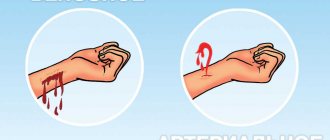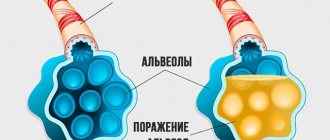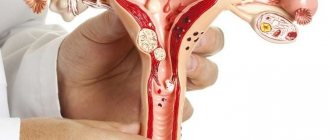Pain syndrome with high blood pressure
Throbbing pain occurs with high blood pressure (BP). At the same time, the following symptoms appear:
- tinnitus;
- dizziness;
- cold sweat and chills;
- pain in the temple area;
- numbness in both extremities and primarily in the left arm.
With a very large pressure surge exceeding 160 per 100 mmHg. Art., the pain intensifies, a stroke may occur.
Elevated blood pressure (from 160 to 100 mm Hg up on the tonometer scale) can be calculated by the following symptoms:
- the pain is of a continuous, pulsating nature;
- when you tilt your head down, the pain intensifies;
- weakness, shortness of breath, nausea, increased heart rate appear;
- The higher the pressure rises, the stronger the pain in the back of the head becomes.
The syndrome intensifies with sudden turns of the head. The pain becomes unbearable when coughing and sneezing. There may be swelling on the face.
Symptoms can only be relieved by taking medications that lower blood pressure. To keep blood pressure at a normal level, it is necessary to organize the correct alternation of physical and mental stress with relaxation, say “no” to bad addictions, and give preference to foods high in nutrients that normalize heart function.
The following procedures will be useful:
- cold and hot shower;
- foot baths with mustard;
- foot compresses made from apple cider vinegar, which is diluted with water in a 1:1 ratio;
- massage of the occipital region.
To massage, you need to find the occipital fossa in the area where the skull adjoins the spine and press on it, holding your finger for 10 seconds. You need to repeat these steps 3-5 times with an interval of 1 minute.
Symptoms of low blood pressure
Hypotonic patients often complain of severe malaise during attacks. They exhibit the following symptom complex:
- loss of strength, general weakness;
- rapid mental and mental fatigue;
- pressing pain in the temples and occipital part, but without clear localization on the head;
- nausea, sometimes vomiting;
- drowsiness, constant yawning against the background of a noticeable lack of oxygen;
- fainting conditions provoked by a sharp deficiency of oxygen in the blood.
Symptoms clearly appear when the weather changes, emotional or physical overload.
Hypotension and hypertension are especially dangerous when you feel nauseous and have a headache, and everything is blurry before your eyes. It is bad if the vessels are constantly narrowed or too dilated. It’s also bad when their tone alternately changes so that a person cannot immediately understand what pressure he has.
It will not only display minute-by-minute information on the parameters of blood vessels and heart rate, but will also help in organizing a healthy lifestyle with information about calories burned, the degree of fatigue, and the fullness of night’s sleep.
Doctors recommend undergoing examination after the first symptoms of abnormal blood pressure. This is a kind of safety net in identifying diseases that are still hidden. A timely step towards a healthy lifestyle is highly likely to relieve the negative consequences of hypo- and hypertension.
- Causes of headache, vomiting and low blood pressure
- Dizziness: severity of symptoms and diagnosis of diseases
- Can high blood pressure cause nausea?
It is not so difficult to cope with headaches, nausea, fever, and fluctuations in blood pressure on your own, but it is better to consult a doctor, because these may be manifestations of serious illnesses that require deep treatment. Even if these signs indicate pregnancy, a doctor's examination is necessary.
What should the patient do and which doctor should he contact?
If you suffer from some kind of chronic disease that leads to dizziness, nausea and weakness, then most likely with these symptoms an exacerbation or attack of the disease occurs. For example, people with diabetes may feel nauseous and dizzy when their sugar drops sharply (especially if they take too much insulin). In such cases, the person knows how to act, since he should have received appropriate instructions from his attending physician.
If you have worked a lot (physically or mentally), then your symptoms are most likely caused by your activity. You should rest, and in the future, plan your work and rest schedule wisely.
Call an ambulance immediately if you experience the following symptoms with dizziness:
- loses consciousness;
- severe dizziness that lasts more than one hour;
- feeling of weakness in the limbs and headache;
- if you have diabetes or hypertension;
- if dizziness is accompanied by fever and vomiting.
If you notice frequent attacks of dizziness, weakness and nausea, then first of all you need to consult a general practitioner. The doctor will conduct a survey, study your medical history and, if necessary, refer you to other specialists for consultation. Perhaps a neurologist, cardiologist, endocrinologist and others. The main thing is not to delay visiting a doctor, but to seek medical help at the first symptoms of illness.
If you are concerned about frequent attacks of nausea, weakness and dizziness, you should consult a doctor. In particular, it is necessary to obtain advice from an otolaryngologist, ophthalmologist, neurologist and endocrinologist. During the initial examination, doctors will refer you for further diagnostic procedures.
Among the laboratory and instrumental diagnostic measures for nausea, dizziness and weakness, the following are most often carried out:
- Blood tests (general and biochemical blood tests).
- Determination of blood glucose levels (including determination of the dynamics of glucose utilization in the blood).
- Electrocardiographic examination of the heart.
- Audiography.
- Tomographic studies (CT, MRI).
- X-ray examination of the skull.
- Ultrasound Dopplerography – to study the condition of cerebral vessels.
As a rule, the above studies are enough to make a diagnosis. In some cases, other specific studies may be required to clarify the diagnosis.
There is no point in treating nausea, weakness and dizziness as a separate symptom. For occasional attacks, you can recommend rest, fresh air and even light exercise, if you are sure that your blood pressure and blood sugar levels are normal.
In other cases, it is necessary to accurately determine the cause of such symptoms and treat the underlying disease. So, with diabetes, the patient must carefully regulate blood sugar levels in order to prevent sudden jumps in glucose. For hypertension, blood pressure control is necessary, and so on. In this case, self-medication is unacceptable. Specialist consultation and proper treatment are necessary.
Headache with low blood pressure
Dystonia or low blood pressure occurs quite often both in people of working age and in elderly people with children. Much more often, arterial hypotension (the scientific name of the disease) is common among women, especially those with a thin build, as well as among pregnant women. Why is dystonia dangerous? What are the main causes of low blood pressure and how does it manifest itself?
So, a headache with low blood pressure is usually accompanied by nausea, severe weakness, drowsiness, dizziness, fainting, slow pulse and pallor. And at the same time, insomnia. That is, low blood pressure is not at all an indicator that a person is guaranteed good sleep and from fatigue he will literally fall asleep on the go. A person develops noise in the head and causeless weakness, the body suffers.
What can be done? The first is to simply go down the steps and go up again. You can eat a spoonful of spicy mustard, make yourself a cheese sandwich, and wash it down with sweet tea with a squeeze of lemon. You can also drink coffee, however, do not forget that the effect of this drink is short-lived and the pressure will drop again after some time. Therefore, it is better to brew cinnamon instead of coffee beans. It wouldn’t hurt to add something stronger than this drink, for example, a little cognac. However, the dose should not exceed 30-50 grams depending on individual response. After taking all this inside, the best thing to do is to get under the covers and get a good night's sleep. If you manage to fall asleep, then when you wake up, the person will feel that there is no more headache, although some malaise and weakness will still remain.
If blood pressure is chronically low, but a person feels normal, then this is not a reason to panic. However, you need to carefully monitor your condition. This pressure is an indicator of how the human vestibular apparatus works. By training it, you can regulate your own pressure. The pressure in the human circulatory system drops due to weather conditions and pressure differences on the Earth's surface. Dystonia can also be a manifestation of the fact that the vessels have lost their tone.
If a headache with low blood pressure causes discomfort to a person, he faints, becomes very dizzy and is bothered by constant weakness - then this is already a serious cause for concern. This condition may be a harbinger of more serious diseases. To get rid of an unnecessary symptom, it is enough to bring the pressure to the required norm, namely, apply all the methods that were described above. However, such measures are appropriate only in the initial stages of hypotension.
In more severe cases, medication cannot be avoided. For people with dystonia, doctors prescribe pentalgin, citramon-p, askofen-p, cofitil and electro-cocoa tincture. Adherents of treatment with herbs and infusions can make a “mix” which includes the following components: electrococoa, Rhodiola rosea, Schisandra, Aralia and Echinacea. This cocktail should be taken 15-30 drops 1-2 times in the morning. But again, you should not indulge in either pharmacological drugs or traditional medicine for a long time, since excessive use can provoke a strong increase in pressure in the body, and, accordingly, cause overexcitation and, as a result, insomnia.
Folk remedies for stabilizing blood pressure
It is impossible to completely get rid of the causes of fluctuations. High blood pressure can be stabilized at home only at the initial stage. The patient may resort to using herbal medicine techniques. Herbal treatment is a supplement. An effective way to reduce it is with medication.
For high blood pressure, the collection includes herbs:
- calming (melissa, valerian, peony);
- regulating the activity of the heart (hawthorn, barberry, chokeberry);
- vasodilators (mint, calendula, St. John's wort) and diuretics (horsetail, dill, string). There must be an equal number of components.
Flax seeds will help stabilize fluctuations. Used as a dressing for salads and dietary dishes. They contain essential fatty acids and normalize lipid metabolism.
Eliminate baked goods from consumption. Consume low-fat fermented milk products more often. They stabilize and improve the functioning of internal organs. Fish and seafood will help lower blood cholesterol levels. They improve blood composition. Useful microelements can be obtained from cold-pressed vegetable oils. Fresh fruits and vegetables help strengthen the heart muscle, relax the arteries, and improve digestion. It is necessary to choose low-fat varieties of meat. They will enrich the body with essential protein. Consume freshly squeezed juices - the level of potassium and sodium is normalized, and the elasticity of blood vessels increases.
You can drink green tea. It helps increase the elasticity of blood vessels and slows down the aging process. To reduce the number of changes in blood flow, drink chilled. We recommend tea that contains hibiscus - the walls of blood vessels are restored, it contains many antioxidants.
- 5 minutes to read
Increased blood pressure, accompanied by dizziness and nausea, is a serious reason to urgently call an ambulance. Symptoms may indicate not only a developed hypertensive crisis, but also be signs of a heart attack or stroke. Only timely medical care will prevent inevitable consequences for the body.
Content
Why is low blood pressure dangerous?
Some people think that hypotension is much better than high blood pressure, because it harms a person less. Sometimes patients do not notice low blood pressure and feel fine. For example, active youth, athletes, dancers. In addition, living conditions in the tropics or in mountainous areas adapt the human body not to feel pressure changes.
However, most people experience considerable discomfort caused by hypotension. Low blood pressure leads to the fact that a person has to live at the limit of his capabilities, constantly feeling depressed and chronic fatigue. This interferes with effective work, leads to the development of depression, and weather changes can take away the last of your strength. As a result, a person becomes unsure of himself and does not get along well with others.
Low blood pressure causes headaches; in addition, this condition is dangerous for humans for the following reasons:
- Blood flow to muscles, internal organs, brain and heart is reduced. As a result, a person often gets motion sickness in transport, and sometimes becomes semi-fainting.
- Dementia and cerebral stroke develop against the background of poor blood flow to the brain.
- In women during menopause, vascular changes may occur, which subsequently leads to hypertension.
To understand the risk of hypotension, you need to determine the cause of its development. If this is due to the presence of any disease, then treatment should begin with the underlying disease. It is worth remembering that blood pressure controls the pulse rate, heartbeat, depth and frequency of breathing, and maintains body temperature. To normalize blood pressure it is recommended:
- Healthy food;
- avoid diets;
- to live an active lifestyle;
- get enough sleep;
- do morning exercises.
Etiology of dizziness
Dizziness varies in intensity. It happens that a person sways a little from side to side. But often it is so strong that it does not allow you to get out of bed, or even open your eyes.
Trying to open your eyes makes you feel sick and often makes you want to vomit. At the same time, the emotional state changes: anger, irritation, tearfulness, and withdrawal appear.
Taking antihypertensive drugs that lower blood pressure causes dizziness. Therefore, it is necessary to monitor the pressure and measure it periodically.
The head feels dizzy with increased pressure due to regulation centers in the cerebral cortex and subcortical formations.
After stimulation of the body system that controls the balance of the body, dizziness is observed. For example, prolonged rotation on a carousel causes dizziness.
The head is dizzy due to pathology for a different reason. The emphasis is on the highest centers of regulation. And they provoke other pathologies besides blood pressure.
With dizziness, there is often a rapid heartbeat, burning and pressure in the heart area, nausea and vomiting, and nosebleeds.
With high blood pressure, you feel dizzy, giving a signal that the pathology is a derivative of not only the pressure regulation system, but also other brain support centers of the body.
The importance of distinguishing between dizziness has created the need for their classification:
- True dizziness of either vestibular origin, i.e. The systemic nature, in turn, is subdivided: central, having a pathological zone in the brain, peripheral as a result of damage to the cerebellum or vestibular nuclei of the brain stem, intermediate is called dizziness, concentrated in the vestibular nerve.
- Unsystematic dizziness with high blood pressure consists of a feeling of instability in maintaining a certain posture. The reason for this is the mismatch of the functions of the nervous system at various levels.
We suggest you read: What increases a person’s blood pressure
Preventive measures
Following the principles of a healthy lifestyle is the best prevention of arterial hypotension. Key recommendations include:
- quitting smoking and drinking large amounts of alcohol;
- maintaining an active lifestyle - daily walking and playing sports, for example, running, fitness, tennis, etc.;
- Swimming will help normalize blood pressure, as well as regular water procedures - taking a contrast shower, dousing, as well as doing breathing exercises;
- a balanced diet, predominantly vegetable and dairy with the obligatory inclusion of fish and seafood;
- adherence to a diet that involves 4-5 meals a day and drinking 2 liters of water;
- adherence to a work and rest schedule that requires 10 hours of sleep, no stress, physical or emotional overload;
- strengthening the immune system, and therefore the nervous system, is facilitated by a course of vitamins C and B12, as well as natural adaptogens - eleutherococcus, aralia, ginseng, hawthorn, Rhodiola rosea, lemongrass, echinacea in the form of infusions or decoctions.
Physical activity for hypotension. Is it worth playing sports?
Quite a few sets of exercises have been developed for hypotensive patients, which are recommended to be performed regularly for two or more months. First of all, they are aimed at supporting the muscle corset and vascular tone, as well as increasing oxygen in the blood, thanks to increased breathing during their implementation. All exercises are performed within forty-five minutes and do not require special preparation.
The patient's condition will improve significantly with an integrated approach, which includes a healthy diet, adherence to a daily routine, walks in the fresh air and physical activity.
Why is low blood pressure dangerous?
Reduced upper and lower pressure for different age categories of patients is fraught with the development of complications. In people after 45-50 years of age, a sharp decrease in systolic and diastolic parameters leads to:
- disruptions in the blood circulation of the brain;
- cardiovascular pathologies;
- internal bleeding;
- development of physical inactivity.
Young people suffering from migraines lose the ability to lead an active lifestyle. Failure of blood vessels can result in oxygen starvation of the brain. Constant vascular spasms cause the development of cardiovascular pathologies.
If a person develops ischemia or other cardiac ailments against the background of hypotension, then these people fall into a risk group that has a high probability of developing a heart attack. With chronic drops in pressure, the risk of developing heart failure increases, as a result of which an acute attack can be fatal.
If young or mature people experience severe pain in the head due to decreased blood pressure, it is necessary to undergo an examination to determine the nature of such hypotension. After diagnosis, the doctor will select therapy to help fight headache attacks.
Signs of a sharp decrease in blood pressure
If you feel dizzy, suddenly begin to feel sick, your vision becomes dark, weakness appears, and your dermis becomes pale, then most likely there is an unexpected decrease in pressure. At this moment, the brain does not receive enough nutrition, the vestibular apparatus is irritated and, as a result, nausea occurs. Hypotension is most often accompanied by throbbing or migraine-like pain, which is localized in the right side of the head.
With orthostatic hypotension, a decrease in pressure occurs when bending down or suddenly rising from a sitting position. A person’s eyes often darken, and small black spots constantly flash in front of them. Due to the constant lack of normal blood supply to vital systems and organs, an individual develops pain in the heart muscle.
Main causes of the condition
Physiological arterial hypotension
This condition is characterized by a stable and regular decrease in blood pressure, falling below 100/60 mm. Hg Art. It is characterized by dizziness, which can lead to transient deterioration of vision, increased fatigue, manifestations of drowsiness, fainting, changes in thermoregulatory processes in the body, etc.
Low blood pressure readings
A decrease in blood pressure leads to the fact that the patient begins to feel discomfort, a headache begins, and:
- symptoms of fatigue, general lethargy, drowsiness, and apathy appear;
- pain in the head is usually felt in the temples and back of the head, it can be dull or throbbing;
- dizziness and fainting may occur;
- Some sufferers of low blood pressure become more irritable and nervous.
Acclimatization
The process of acclimatization (adjustment of the body to changes in climate and geographic location) may be accompanied by headaches and low blood pressure, poor sleep and a feeling of weakness throughout the body. Acclimatization may have symptoms of a common cold. Sometimes there are disorders of the gastrointestinal tract with pain in the abdomen, nausea, vomiting and disorders.
Often, all these signs begin to manifest themselves 2-3 days after changing the usual living conditions. But for some people, acclimatization can last 2–14 days.
Sharp drop in blood pressure
This condition is a sign of various pathologies. A sharp decline in blood pressure in women is 95/60 mmHg, in men it is below 100/60 mmHg. A sharp drop in blood pressure can be a consequence of diseases of the cardiovascular system, severe heart failure, and deterioration of blood circulation. Often a sharp drop in blood pressure occurs as a result of complex intoxications caused by drugs, alcohol, and fast-acting medications.
A sharp decrease in blood pressure is a sign of complications that arise from a certain disease, therefore, to normalize this condition, it is necessary to determine the cause that caused it. Symptoms:
- orthostatic hypotension with an even stronger decrease in blood pressure when the body position changes (from horizontal to vertical, and vice versa);
- short duration of this state (several minutes);
- usually manifests itself in the morning, accompanied by a disruption of the body’s natural blood circulation and supply to the brain;
- darkening of the eyes;
- tinnitus, dizziness, loss of consciousness;
- the chronic condition of orthostatic hypotension can lead to lethargy, weakness, irritability, organ tension and an inability to relax;
- intolerance to heat, cold, stuffy rooms, etc.
They can appear both at low and high atmospheric pressure. A blood pressure of 750 mmHg is considered normal.
Diagnostics
To diagnose hypertension or stroke due to increased blood pressure, the following methods are used:
- interview . The patient states what exactly is bothering him: dizziness, nausea, vomiting, headache; periods when symptoms appear; what precedes it; duration of symptoms.
- Conducting clinical studies (blood and urine tests to identify pathologies).
- Blood pressure measurement . You can track your readings throughout the day yourself using a tonometer. In some cases, the doctor uses the method of daily pressure recording. The device is attached to a person’s belt, and the cuff is attached to the arm. During the day, every 15-20 minutes, the device records indicators, at night every half hour. Fixation is performed under standard conditions for the patient.
- An ECG is a detailed examination of the heart. The method allows you to determine existing birth defects or identify acquired ones.
- Dopplerography is a method aimed at identifying existing disturbances in vascular patency.
- Ateriography is a method that helps to determine the condition of the walls of blood vessels, the formation of plaques, and existing damage to the arteries.
- Examination by an ophthalmologist. Developed hypertension is characterized by a change in the vascular structure of the eye; as the disease progresses, visual acuity is lost and the proper functioning of the eyeball is disrupted.
- Ultrasound of the kidneys and adrenal glands. The kidneys are involved in filtering blood. If a person suffers from hypertension, then the nephrons in the filtering organ die, which cleanse the blood of toxins. The accumulation of waste is displayed on ultrasound, which indicates a certain stage of hypertension.
To diagnose a stroke, effective methods such as MRI and CT are used, which make it possible to assess the location of the brain lesion and the extent of damage.
Why is my blood pressure constantly low?
For some people, hypotension is a normal condition; they feel cheerful, work well and do not complain about their health. This phenomenon is called physiological.
The reason for low pressure is as follows:
- Heredity. Small children with low blood pressure are inactive, lethargic and get tired very quickly when participating in active games. Adults with hypotension are tall and light in weight.
- Frequent strong psycho-emotional stress.
- Prolonged mental work.
- The person moves little and is not active.
- Working in hazardous conditions.
- Diseases of the nervous system, heart, respiratory system, adrenal glands and thyroid gland.
Drug therapy
Low blood pressure, how to increase it? In the arsenal of doctors there are different groups of drugs that are used for these purposes. The most commonly recommended treatment is:
- Alpha adrenergic agonists - Phenylephrine, Norepinephrine.
- Anticholinergic drugs - reduce the synthesis of acetylcholine and promote vasoconstriction.
- Adaptogens – stimulate the cardiovascular system and eliminate symptoms of low blood pressure: tincture of eleutherococcus, ginseng, lemongrass and others.
- Central nervous system stimulants – relieve fatigue and drowsiness, increase the speed of reactions.
- Vitamin and mineral complexes - to strengthen a weakened body.
Causes
Violations of vegetative-hormonal regulation lead to ill health. With low tone of the cerebral arteries, prolonged aching pain is felt in the parietal and temporal regions, along the entire circumference of the head. With decreased tone of the venous vessels, a person will feel a bursting pain in the back of the head.
Hypotensive headaches often occur after daytime sleep, physical and mental stress, and in the first months of pregnancy. Your head may feel dizzy when you spend a long time in transport or in a stuffy room, while going down the subway, or when you skip a meal. This type of pain often occurs during pregnancy.
The patient experiences a decrease in the temperature of the extremities - the palms and soles quickly become cold and wet, and a feeling of numbness occurs. Redness may appear on the neck and chest. In the morning, when you suddenly get out of bed, a short-term darkening of the eyes may occur.
Painful health is often accompanied by:
- rapid heartbeat,
- yawning,
- dizziness,
- nausea,
- deterioration of vision,
- fainting,
- vomiting.
If during an attack the sufferer is able to fall asleep, then, most likely, he will wake up without headaches, but the feeling of weakness and weakness will remain.
Throughout the day, adults may experience a decrease in performance, and children may experience a decrease in learning ability.
First aid
If you suddenly feel severe dizziness or nausea, call an ambulance immediately. Often, a person’s future life depends on how timely and correctly first aid was provided.
Your required actions are:
- help the patient take a lying position;
- You need to put a couple of pillows under your head;
- open the windows for fresh air;
- Free your body from constrictive clothing.
When the pressure constantly fluctuates, a hypertensive patient can be given a fast-acting tablet that lowers blood pressure. If an attack of dizziness occurs for the first time, then no medications should be taken until the doctor arrives.
Mechanism of pain
When, at low pressure, the movement of blood through the arterioles and small arteries is disrupted, their tone decreases, and arterial inflow increases.
The pain occurs due to stretching of the arteries, its nature is pulsating, aching, mainly localized in the temporo-parietal region, sometimes in the occipital region. A different type of pain is localized in the back of the head, when the venous vessels lose their tone, the outflow of blood from the cranial cavity becomes difficult, and a feeling of heaviness appears. An increase in heaviness is perceived as pressure from within; such pain appears when a person is in a horizontal position or with his head bowed. When the patient is in an upright position, engaged in any activity, the condition gradually stabilizes, as the tone of the veins increases.
Treatment of weather dependence
The ICD (International Classification of Diseases) does not have a section on weather dependence, but there is a beautiful phrase “somatoform autonomic dysfunction (SVD). Weather dependence, together with asthenic syndrome (weakness, fatigue, intolerance to physical and mental stress), is included in the syndrome of adaptation disorders in vegetative-vascular dystonia, which is a characteristic syndrome for many diseases. It often happens that it is weather dependence that gives impetus and motivation to a healthy lifestyle.
How to treat weather dependence
It all depends on which symptom is most troubling. Nowadays you rarely meet an absolutely healthy person; everyone can have at least one chronic disease, or even several. This or that disease affects the autonomic nervous system in its own way. Something activates the sympathetic nervous system, and something has a greater effect on the parasympathetic system, with all the ensuing consequences. Healthy people rarely suffer from weather dependence, so in case of weather dependence, the underlying disease must first be treated, but if there is none, then you need to seek help from a psychotherapist and stop beating yourself up by looking for a serious incurable disease. A healthy lifestyle is recommended for absolutely everyone, and if there is a great desire to stop suffering from weather dependence, then you can achieve the desired result through proper nutrition, eating foods rich in magnesium, potassium, calcium and vitamins, dosed physical activity (according to age), cold dousing water. The latter greatly strengthen the nervous system and train blood vessels, but they must be done only using the correct method.
Why does a headache begin to hurt when the atmospheric pressure drops due to weather dependence?
When the atmospheric pressure decreases (and this happens during a cyclone, in bad rainy weather, before a thunderstorm), intracranial pressure (the pressure of the cerebrospinal fluid on the brain) does not have time to decrease either, and begins to be felt in the form of a headache. With normal cerebrospinal fluid dynamics, this is not so noticeable, but with increased production of cerebrospinal fluid or disruption of its outflow from the ventricles of the brain, with meteodependence, a bursting headache is disturbing. In the morning, weather-sensitive people should not get out of bed abruptly; first they need to lie down on a high pillow and do breathing exercises. Taking water with lemon on an empty stomach has a good effect in case of weather dependence.
Also, with low atmospheric pressure, blood pressure may decrease and begin to make you sleepy. If you can lie down to sleep at home, then at work you can’t do without green tea, coffee or pills. Citramon is ideal in this case: it lowers intracranial pressure and increases blood pressure (due to the presence of acetylsalicylic acid in its composition, which has a teratogenic effect on the fetus during critical periods of its development, its use during pregnancy is not recommended). Glycerin only reduces intracranial pressure and causes increased stress on the heart due to the transfer of fluid into the bloodstream. Its use is contraindicated in case of weakened cardiac activity, including after myocardial infarction.
Hypotonic patients are advised to take adaptogens in courses (tinctures of ginseng, eleutherococcus, aralia, lemongrass). But also provided there are no contraindications.
In case of weather dependence, injections of B vitamins, massage of the collar area, physiotherapy (as prescribed by a doctor), acupressure of biologically active points help.
If, due to weather dependence, blood pressure, on the contrary, increases, then you can start treatment with light sedatives (tincture of valerian, motherwort, Novo-Passita), diuretic herbs (lingonberry leaf, bearberry, various urological preparations, taking into account contraindications) can help.
Weather dependence, combined with headache, hypertensive crisis, requires urgent treatment with the use of drugs that effectively normalize blood pressure. Due to the risk of developing a stroke or heart attack, therapy for such manifestations of weather dependence should be carried out immediately and only as prescribed by a doctor.
Weather dependence and traditional medicine
Self-massage of the so-called “anatomical snuffbox” helps with headaches; in acupuncture it is called the Yang Xi point.
And another BAT, as shown in the video:
https://youtube.com/watch?v=uDAy2WMF2Dw
Consequences
Low blood pressure rarely leads to heart attacks and strokes.
But it can pose a threat to the development of other serious diseases. With low blood pressure, the headache can be quite severe. If you ignore it, you can bring the body to a state where chemical processes in the brain begin to disturb. Over time, the pain can become chronic, and this will require significant funds and time for full treatment. It is best to consult a neurologist if you have headaches or low blood pressure.
Therapeutic methods
Medications commonly prescribed to treat headaches caused by low blood pressure include:
- Caffeine – no more than 1.5 grams per day. Take 2-3 times, 0.2 g each. You can take up to 0.5 g at a time. The duration of treatment is several weeks. Contraindicated for insomnia, severe heart disease, vascular disease, increased excitability, glaucoma, after 70 years.
- Citramon - take only for headaches caused by the outflow of blood from the vascular system, which has led to a decrease in their tone. Drink 1 tablet. 2-3 times a day after meals. The maximum amount of the drug is 6 tablets/day. Contraindicated for kidney disease, liver disease, ulcers, stomach, intestinal bleeding, diathesis. In case of bronchial asthma it can cause suffocation.
- Ortho taurine – take 1 capsule 2-3 times a day before meals. The duration of treatment is no more than 1 month. Contraindicated in case of individual intolerance.
Phytotherapy
Extracts of the following plants also effectively stabilize blood pressure:
- Ginseng, you need to take it 5-10 drops twice a day for 2-3 weeks;
- Golden root - from 10 to 40 drops twice a day, half an hour before meals, course of treatment - 10-20 days;
- Leuzea safflower - 10-30 drops twice a day, duration of administration is at your discretion;
- Eleutherococcus - 20-30 drops half an hour before meals, duration of treatment is at your discretion.
Traditional methods
Folk remedies for the treatment of hypotension require an individual approach. Some people find relief from a heating pad applied to their head, nose, neck or chest; others feel better with a cup of strong coffee or tea. Sometimes a small amount of alcohol (red wine or cognac) helps get rid of this problem. You can try rubbing tea with lemon on your nose and palms.
Raisins are an Ayurvedic remedy for the treatment of hypotension. You need to pour about 40 raisins in a glass of water overnight and eat them in the morning on an empty stomach. Can be taken for up to 1 month.
It is necessary to monitor your blood pressure and know the reason for its decrease, since it can be a dangerous harbinger of diseases such as tuberculosis, stomach ulcers, and heart disease.
Prevention of low blood pressure
The urge to vomit against a background of low blood pressure is a dangerous indicator that demonstrates the presence of problems with the cardiovascular or other body systems.
In order not to bring your health to a critical state, it is necessary to take preventive measures in time to strengthen blood vessels and normalize their tone.
According to recent studies, people at risk for developing arterial hypotension are:
- smoking and leading an unhealthy lifestyle;
- those who eat irrationally and “as needed” (which often happens among students or single men);
- those in stressful situations or physically overworked;
- those engaged in mental work and other “sedentary” work;
- following strict diets;
- frequently changing climatic living conditions (actively traveling);
- those who are often ill or have had illnesses associated with large blood losses (including girls who menstruate heavily), severe vomiting or diarrhea.
Based on this list, we can conclude that to prevent hypotension it is necessary, if possible, to get rid of all these provoking factors.
No matter how difficult it may seem, a healthy lifestyle is the key to the well-being of the cardiovascular system and the main point in the prevention of hypotension.
To maintain normotension (normal vascular tone), it is useful to observe several conditions:
- Eat nutritiously and on time, including a sufficient amount of proteins, fats, carbohydrates, vitamins and other useful elements in your diet.
- Do not take long breaks between meals (to prevent metabolic disorders), eat 4-5 times a day in small portions.
- Do not smoke or harm your health in other ways.
- Dose physical, mental and emotional stress (do not take on overtime work, do not be nervous about any reason).
- Try to avoid sudden changes in climatic zones when traveling (it is especially dangerous to be in hot countries during winter).
- Monitor your health and promptly treat infections, diseases of internal organs, and intoxication.
- Find time to stay in the fresh air and exercise (daily morning exercises, walking, fitness several times a week are a great option).
- To strengthen the tone and elasticity of blood vessels, it is useful to temper moderately, take contrast showers, and “air baths.”
If blood pressure decreases, accompanied by nausea, weakness, dizziness, or low pulse, it is necessary to resort to methods approved by official medicine.
Do not get carried away with drinking coffee and other tonic drinks, which provoke tachycardia (increased heart rate) and create increased stress on the heart.
It is wrong to think that you can do hypotension and eat everything that is prohibited for people with arterial hypertension (high blood pressure).
You should not get carried away with fatty, salty, smoked, fried foods - they contribute to the deposition of cholesterol in the walls of blood vessels, which sooner or later occurs in every body and creates the risk of developing atherosclerosis.
Remember: from hypotension to arterial hypertension is just one step.
Nausea and vomiting with low blood pressure
Nausea with high blood pressure, what should I do?
If in your case the abdominal pain accompanying nausea and vomiting is very strong, be sure to study our recommendations in the article Abdominal pain. Below we will describe the most common situations in which heart and vascular diseases are manifested by nausea and vomiting. Nausea, vomiting, headaches and fever with meningitis occur suddenly and get worse quickly. The causes of low blood pressure - hypotension or hypotension - can be very different. Normal blood pressure is 90-120 mm Hg upper (i.e. systolic) and 60-90 mm Hg lower (i.e. diastolic).
Causes, signs and symptoms of low blood pressure
A sudden and short-lived episode of low blood pressure is often the result of physical or emotional fatigue, poor sleep and an unbalanced diet. First, strengthen your immune system and get rid of parasites. This may also cause weakness and dizziness, increased heart rate, sudden sweating, involuntary drooling and involuntary swallowing movements.
Treatment of nausea and vomiting
Hypotension can appear suddenly, against the background of complete health, and pass quickly, or arise as a result of a certain pathology, and haunt a person for years. Low blood pressure causes a lot of problems for people. This phenomenon should be divided as primary and secondary; spicy #8212; sudden and chronic. Babies #8212; hypotensive people are lethargic and get tired quickly.
Among the numerous compensatory reactions of the human body in such a situation, short-term signs of weakness, nausea and tachycardia (increased heart rate) are most often observed. The tendency to low blood pressure can be gradual and long-lasting. With orthostatic hypotension, a decrease in blood pressure occurs when standing up suddenly or bending down. A person develops “floaters” before his eyes and his vision becomes dark.
Often people with low blood pressure are inhibited or, conversely, suffer from emotional instability. Among the drugs that increase blood pressure, one can highlight drugs based on Caffeine, Ergotamine (Coffetamine), Dihydroergotamine (Ditamine) and Dopamine (Dopamine Solvay). These medications should be prescribed by a doctor, taking into account the causes of the disease, the benefits and possible harm to the person.
Before using advice and information from the site, please read the clarifications and warnings on the project page. For people whose blood pressure often fluctuates, nausea is an inevitable sign that their condition will soon worsen.
Only stabilization of the condition helps to avoid worsening of both symptoms and pressure. But, in some cases, it is no longer possible to do without calling an ambulance. Many people are tormented by the question: “At what pressure does one feel sick?”
Causes of low blood pressure
And if the patient knows what he is more predisposed to, then he is simply obliged to take measures to alleviate his well-being. Regardless of which of the above reasons caused the appearance of this condition, it is necessary to increase the pressure as quickly as possible. Quite often, nausea occurs with low blood pressure due to the low level of hemoglobin. This condition can recur quite often. To normalize its level, it is necessary not only to introduce iron-containing foods into the diet, but also to take a number of iron supplements.
Therapeutic measures
Increased blood pressure is often not felt by a person. Therefore, the expression “silent killer” was attached to him.
This is the main danger when a person’s health is undermined to the point of a stroke or heart attack.
And everything happened unnoticed. The person didn’t think about high blood pressure.
Experienced hypertensive patients pay attention to changes in their well-being, assessing any factor:
- nausea;
- interruptions in heart rhythm;
- soreness in the sternum;
- dizziness;
- headache.
At the same time, the pressure is measured and based on its indicators one can draw a conclusion about its jump.
At the beginning of the development of pathology, some symptoms are present, as it worsens, others are added.
With advanced forms of pressure, the following are present:
- swelling;
- shortness of breath during vigorous activity;
- later shortness of breath appears even without workload, at rest.
If you have high blood pressure, treatment is necessary, regardless of the stage and level of severity. Otherwise, it undermines healthy organs, causing irreversible consequences in them.
Treatment requires an individual approach to each patient due to the many options, schemes and techniques.
Considering that the treatment will consist of taking medication, and is unlikely to be limited to one type, then side effects will become another problem.
Now my head is dizzy not only from high blood pressure, but also from taking medications. The same can be said about nausea and vomiting.
Therefore, realizing the importance of preventing strokes and heart attacks, treatment must be carried out with the knowledge of a doctor. Do not hesitate to ask to replace a heavy medicine with another drug.
In addition to medications, you need to remember the recommendations of nutritionists on nutrition, eradicating habits associated with smoking and alcohol, and stabilizing your daily routine by adding proper rest.
In addition to the well-known rules, you can find other ways to help your body fight the development of pressure.
Although pressure does not select people by age, it still haunts those who have entered the honorable age of 60 more.
This contingent knows about pressure firsthand, and they themselves suffer from it.
It is an established fact that 15% of patients try to lower it. The rest of the people accept the disease with monstrous tolerance.
But by controlling blood pressure, making it a habit before serious complications appear in the body, you can increase your life expectancy by decades.
The progress of science has dealt an indestructible blow to the stereotypes of treatment, in which it is mandatory to drink half a package of all kinds of medicines in order to get rid of symptoms - dizziness, nausea, etc.
After such stereotypes, you need to find the strength to be treated with useful amino acids, minerals, and vitamins.
No matter what level of severity the development of the pathology is, a competent complex will not only stabilize the pressure, but after its use it will strengthen the health of all organs.
When you follow the selected methodology, the shortest possible time will become a grave for pressure.
We suggest you read: How rose hips affect blood pressure • How to cure hypertension
With pressure, modern treatment has taken on an interesting trend. It addresses a complex of useful elements:
- magnesium;
- vitamin B6;
- amino acid taurine;
- Omega - 3.
Each of them is used in the treatment of hypertension. There is a calculated scale for how much and in what products these substances are contained.
You can create your own menu based on your daily intake of these nutrients.
Such a menu is a labor-intensive task, my head is spinning from such stress. But what can you do to make your head clear?
After absorbing useful dietary supplements, you can forget the condition why you are dizzy only by adhering to proper nutrition.
The combination of all measures will allow you to get rid of hypertension and the cause that caused it.
The main enemies of normal blood flow are cortisol, norepinephrine, and adrenaline, called stress hormones.
They provoke rapid heartbeat and breathing, rapidly increasing vascular tone with simultaneous peripheral resistance.
These are the reasons for the increased workload of the heart muscle, because each contraction ejects a large volume of blood.
After a short period, the dilated vessels necessarily narrow, almost to the point of spasms.
The dietary supplements taken suppress panic in the blood by normalizing carbon dioxide and oxygen.
Vasodilation occurs, there are no spasms, the pressure decreases naturally. This is the mechanism of action of all dietary supplements, regardless of their composition.











